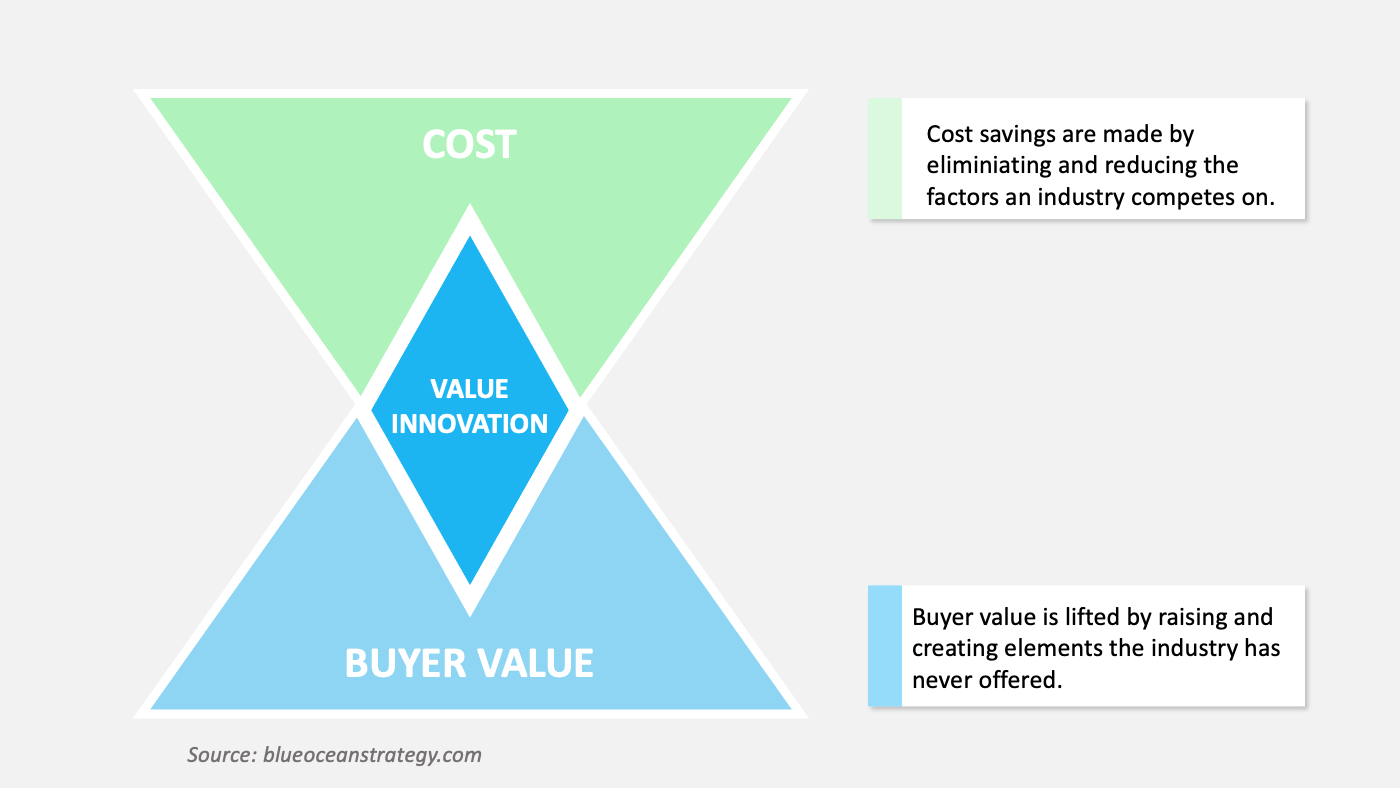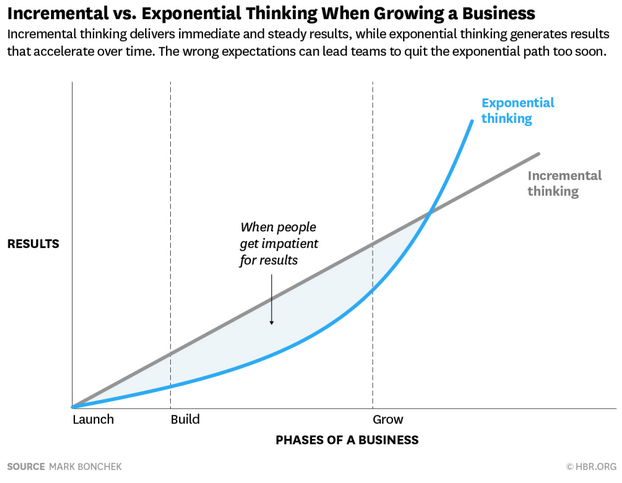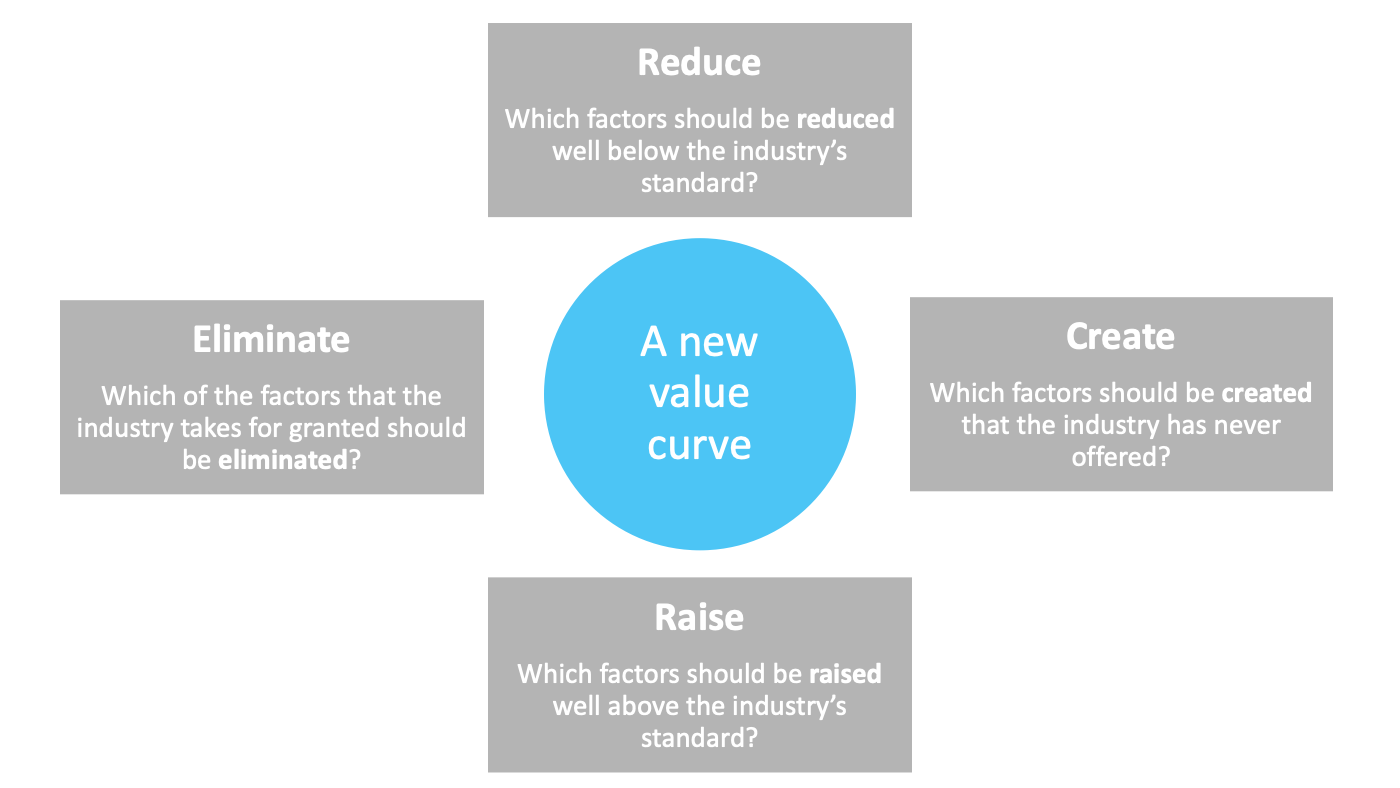What is Value Innovation and Why Does It Matter?
In an increasing technologically driven society, there’s great potential for growth, new markets, and new business models. With this comes an increasingly fierce competition which makes it harder for companies to keep afloat.
If you’re like most organizations out there, you’re trying to step up your game by differentiating yourself from your competition. Traditionally, this is done either by increasing value or by lowering prices.
Most companies choose between value and pricing and that’s where they go wrong. If you want to stay ahead of the curve and avoid brutal competition, you need to break the value-cost trade-off. This is what we call value innovation.
In this blog we’ll explain the concept of value innovation and show you how to put it in practice. This can help you redefine market boundaries and leave behind the most crowded markets.
Table of contents
What is value innovation
Value innovation is the cornerstone of the Blue Ocean Strategy theory and framework developed by W. Chan Kim and Renée Mauborgne in their book with the same title.
First things first, what is Blue Ocean Strategy?
Blue oceans refer to all the unexplored or unknown markets. Red oceans, the existing markets, are filled with fierce competition that eliminates profit whereas the blue ones are untouched by competition and thus full of opportunity for profitable growth. So, the Blue Ocean Strategy simply refers to creating new demand by developing uncontested market space instead of competing in the crowded red ocean colored by the blood of everyone that swims in it.
How can one achieve that? Through value innovation.
Value innovation is the simultaneous pursuit of differentiation and low cost. The conventional approach to market differentiation is to choose between higher value and lower cost. But when you successfully combine low cost and high value, you have succeeded at value innovation.
When you successfully combine low cost and high value, you have succeeded at value innovation.
However, to get there, you can’t just make minor tweaks to what competitors are doing. Instead, you need to rethink the market, uncover currently unmet needs and opportunities, while simultaneously eliminating elements already provided by others in the market. Usually this will lead to you serving a specific subsegment of the market, or to finding an adjacent one.
It’s not easy to merge a paradoxical combination of high value and low cost but getting there is a strategic move with plenty of benefits. Let’s see what those are.
Why is value innovation important?
It’s only natural that every company wants to avoid competition. Going outside of their market boundaries is one way to do that.
This approach could go two ways: you either run from your competitors but land in another market with new competition, or you create uncontested market space. Your goal is the latter and value innovation can help you get there. And along the way you can reap other benefits too:
Make the competition irrelevant
As mentioned, in a traditional setting, growth and performance are achieved when you manage to beat competition. When you focus on beating the competition you work on small improvements which are good, but not enough to give you a leading position for too long.
Even more, this approach means that you limit the time and resources you allocate to identifying new innovation opportunities. When you pursue value innovation you focus on adding higher value at lower costs, so you make the competition irrelevant.

Let’s take a classic example of value innovation from the early 2000s. Back in the days when high-resolution graphics where the new thing in the console games industry, Microsoft, Sony and Nintendo were competing for the leading position.
Nintendo decided not to focus on HD and created the Nintendo Wii, aimed at serving a new market, the casual gamers. By not pursuing the technologically most demanding segment of the market, they were able to lower production costs while increasing value for the customers in their new target segment, the casual gamer consisting primarily of families with young children.
A great success at the time, becoming a sales-leaders with over 100 million units sold, Nintendo is also the perfect example that makes the point about staying vigilant. The company’s initial success was short lived, and Wii was ultimately outperformed and discontinued.
They made a comeback with the Nintendo Switch, but in terms of costs, they didn’t quite hit the value innovation goal. However, it’s important to note that their approach is a good example of Blue Ocean Strategy as they were not competing with high-end PS and Xbox consoles but addressed an entirely new segment.
Cost savings
Usually, high value comes at a higher cost for the company. But with value innovation you can have the cake and eat it too.
If you want to get value innovation right, you reduce costs by eliminating and reducing factors that don’t meet the market standards or are simply unnecessary.
Let’s take the example of the Accor company, and their Formule 1 range of hotels launched in the mid-80s. To provide their customers with a good night sleep at a low price, they removed costly features such as lobbies, 24/7 open receptions, big closets, desks, or stationery.
Saving costs on building rooms and employing personnel allowed them to invest in what customers would value more: a good bed that provided a good sleep.
Create an exponential mindset
Another noteworthy benefit of value innovation is the unconventional thinking that it comes with.
Successful companies focus on exponential value, not just on incremental improvements. While both have their role in the growth of a business, there is a big difference between the two.
Incremental thinking is about making something 10% better while the exponential thinking is about how to be 10x better by making something different. The 10% is a plane taking you from A to B, while the 10x is a rocket launching into space.
When companies compete for the same market share, their strategy is mostly built around incremental improvements that give a competitive advantage, until they are surpassed or outperformed again, and the process starts all over.
However, with value innovation you take a different path, that requires an exponential kind of mindset, which means that you constantly look for new opportunities. Leaders that pursue value innovation and have an exponential thinking want to be 10x better, not just to improve 10%.

Going back to the Accor chain hotel, they are a good example of how you can discard conventional thinking and adopt the exponential one. Accor created Formule 1 after reimagining what budget hotels can be. They focused on bringing value to customer while discarding unnecessary, costly elements.
Now, let’s look at some practical methods you can use to create value innovation in your business.
How to get started
Value innovation is the cornerstone of Blue Ocean Strategy so it’s good to start by revisiting your existing strategy within a specific project or a department. Any good strategy has a clear focus and precise goals. When you want to succeed with value innovation these don’t have to change.
However, you should drift away from the competition obsession and focus on the "noncustomers" and how you can create more value for them.
For this you don’t have to leave your existing market, but you need to identify the opportunities for differentiation so you can create new markets. In the process you’ll have to find new ways to provide value for customers and for the company too.
Let’s see how you can get started in five steps and what it takes to achieve value innovation in your organization.
1. Analyze your current state
Where are you positioned on the market, what is your role in the industry in terms of what needs you meet compared to other competitors? Can you see any differences and similarities between your overall strategy and the one of your competitors?
The purpose of this lightweight benchmarking is not to replicate what others do but to spot the differences and the gaps that you could fill. The Innovation System coaching program we developed for innovators comes with a ready-made Blue Ocean Strategy template you can use at this stage.
2. Reveal the four actions framework
In their book, W. Chan Kim and Renée Mauborgne talk about the four actions framework as a tool to reveal unseen truths about your industry. The framework can help you discover new possible offerings on the market.
There are four questions you should ask yourself to discover the action frameworks.

The first two are related to ways through which you can eliminate and reduce costs and the other two provide insight into how you could raise more buyer value and create new demand.
a. Which factors that are taken for granted in the industry should be eliminated?
b. Which factors should be reduced below the industry’s standard?
The first question should make you think of competitors’ offering if what they compete for no longer brings value or what customers value has changed. This can happen when companies are too busy competing against each other and end up in a race for features.
The answer to the second question should help you uncover products and services that have been over-designed or over-engineered for competitive advantage – or just for the sake of innovation.
For example, the Segway transporter is one of the most famous flops when it comes to technology innovation. While innovative at the time, it never delivered to its promise. Too many features made it expensive, too large, and not very useful.
Love them or hate them, E-scooters, use similar technology and bring value innovation to the equation. Features such as a long-lasting battery were eliminated since nobody is on a scooter for that many hours at a time, and it was also made much smaller for easier transportation and storage, and it all came at a lower cost. No wonder cities around the world are now packed with these e-scooters.
c. Which factors should be raised above the industry’s standard?
d. Which factors should be created and are not available in the industry?
The third question can reveal the compromises customers have to make when choosing a solution. If you can pinpoint to these compromises, and eliminate them, your solution should replace them with something better.
The fourth question completes the previous one and helps you discover completely new value sources. Based on this you can create new demand.
3. Rethink your strategy
After you gathered all the information is time to go back to the drawing board and rethink your strategy. As mentioned, you probably have a core strategy and goals on which you can build. So most likely you won’t start from zero.
Use the answers from the previous step to create your own value curve. A value curve is a graphic depiction of your performance across the industry’s key success factors. This will clarify your position in the market and the touch points to work on.
4. Action plan
Based on your strategy, you should be ready to draw an action plan for implementation. The smart way to go around this is to start on a small scale, to test if your assumptions were actually correct.
5. Keep a superior value curve
Highly performant companies keep an eye on the competition to see if they are trying to imitate their value curve. The speed at which others might try to catch up and imitate your value curve depends on the industry. However, it seems inevitable for that to happen.
So maybe even better than looking out for the competition, is to focus on value creation. You never know when you have to jump to a next value innovation.
Just like in the Nintendo example, their Wii lost its positions, but they came back with the Switch, another big success. Their exponential thinking and systematic approach to innovation made all the difference.
Key success factors for value innovation
There is a common misconception that innovation is about technological breakthroughs. Value innovation shows that’s clearly not the case. The conventional strategic focus for many companies is to beat their competition through a competitive advantage.

The value innovation logic, however, is to start from a blank canvas and look for specific subsegments and their key value drivers. You can’t provide everything for everyone.
In other words, you should be on the lookout for the “noncustomers”, those whose needs have been poorly met or not at all.
For this you don’t need any big technical breakthrough. You need a unique value logic which might use tech as an enabler, but it can be centered around business models, operations or marketing.
You need a unique value logic which might use tech as an enabler, but it can be centered around business models, operations or marketing.
Now, the question is how to come up with a strategic value innovation logic and what are the key factors that contribute to a successful outcome?
Identify and communicate the strategic logic
A good strategy has a focus and, in this context, you should frame your strategic logic around value innovation. The five basic elements of a strategy can show your current position. This has to be clearly communicated throughout the organization and both middle and top management play key roles here.
Once you’ve found your focus it’s good to communicate and promote value innovation throughout the organization. If you want to be a pioneer in your industry and generate profitable growth you need to challenge the status quo, which takes us to the next major success factor.
Challenge the industry’s assumptions
One of the common mistakes among companies operating in the conventional strategic logic is to base their decisions on industries’ assumptions.
If you want to sail on your blue ocean, you shouldn’t be misguided by the given conditions. Instead, uncover the four actions framework and challenge these assumptions.
Kinepolis, the first megaplex in the world, challenged the assumptions of what the cinema industry should look like and made a leap in the value they provided customers. But more on this case and their success story, in the examples section.
Approach innovation holistically
The Blue Ocean Strategy uses the three platforms (product, service, and delivery) to approach innovation holistically. However, we found that the 10 types of innovation framework is a more actionable and easily understandable format in this case.
With this, you can work at bringing value innovation in more areas, which will increase and maintain your advantage for longer.
Examples
There are many examples that perfectly showcase value innovation in action. Let’s look at just a few to understand what contributed to their success and how they reframed their strategy around value innovation.
Kinepolis
Kinepolis has become a leader in the cinema operator’s industry in the late 80s when movie theaters were losing ground in front of the cable television and videocassette recorders.
Instead of throwing the towel, they challenged the assumptions about what cinema is, identified radical ideas and made big leaps in the value they provided. The creators of the Kinepolis megaplex offered an enhanced experience to customers, at a lower price.
Value innovation is not about low pricing, but about strategic pricing as Kinepolis showed. They shifted their focus on value innovation by going outside of the city centers, where they could build cheaper. The conventional assumption was that people valued more the location of the movie theatres.
A Kinepolis viewing room could host up to 700 people, screens are bigger and seats more comfortable and spacious. Because they were able to cut costs in areas that usually require more investments, they didn’t have to increase their prices.
The Belgian company managed to expand the market by 40% and win 50% of the market in their first year.

As expected, since their breakthrough other cinema operators followed their path. In addition, other factors such as the rise of streaming services and even the pandemic require a new value innovation curve.
Virgin Atlantic
Another example, also dating back to the 80’s is the Virgin Atlantic Airways case. The airline took a bold decision and eliminated first class services. These services generated more costs while the business class was bringing more revenue.
Virgin’s value innovation came in the form of greater seat comfort, additional services like seat-back video screens, transportation to and from the airport, lounges for travelling businesspeople and other similar services. They challenged the industry assumptions, eliminated first class, and created more value for customers.
Today, other airlines have adopted similar models and the market has become very competitive. However, Virign Atlantic managed to expand to other industries as well, were they applied the same value innovation logic.
Viima
While we’re not as famous as some of the other examples, we’ve always had value innovation as a key strategy at Viima. We aim to be both much better, and much more affordable.
We’re in a highly competitive market and realized that most vendors in the industry are locked in a battle to try to provide even more complex features and modules for the needs of a few of the most demanding and lucrative customers. This strategy has historically been a good way to create more value and has been a good growth strategy for those in the industry.
However, we realized that while those characteristics are important for some, for most companies out there, they weren’t. What most organizations need is a flexible idea and innovation management tool for different purposes across the organization.
What most organizations need is a flexible tool for managing ideas and innovations for different purposes across the organization.
For them, flexibility, ease of use, and high user engagement are the most important drivers of value. Where new features are easy to copy, the fundamental design decisions we’ve made in our software are nearly impossible for our competitors to copy if they don’t start from scratch.

However, to really drive the growth of the market beyond just the huge deep-pocketed companies that our competitors are after, we’ve went for a fundamentally different business and operating models.
We have a free Basic Plan that is available for an unlimited number of users. This extremely generous offering leads to hundreds of companies signing up every month and naturally decreases our customer acquisition costs dramatically. We’ve also eliminated or minimized several big cost centers that others in the industry have. Put together, this allows us to also offer the lowest prices on the market.
Conclusion
In theory, value innovation is simple and straightforward, but you should keep in mind that putting it in practice is rarely easy, and often requires big changes throughout the business.
On a more positive note, if you shift your attention from the race to match competition to creating value for customers, you can make competition irrelevant. This starts with a nuanced understanding of your industry and customers. With the right choices, you can often achieve both differentiation and low cost.
While value innovation is a powerful tool to drive profitable growth, it won’t miraculously fix everything. You need to continue innovating to stay on top of your game when the competition will inevitably follow you. Still, finding the right ways to pursue value innovation should always be a part of your strategic innovation efforts.
If you want a flexible tool for managing ideas and innovations for different purposes, try Viima. It's free!
Interested in Innovation and Leadership?
Subscribe to our blog to get the latest stories on innovation, leadership and culture straight to your inbox.








